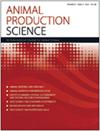Evaluation of feed efficiency traits in different Hereford populations and their effect on variance component estimation
IF 1.2
4区 农林科学
Q3 AGRICULTURE, DAIRY & ANIMAL SCIENCE
引用次数: 0
Abstract
Context Residual feed intake is a relevant trait for beef cattle, given the positive impact on reducing feeding costs and greenhouse gas emissions. The lack of large databases is a restriction when estimating accurate genetic parameters for dry matter intake (DMI) and residual feed intake (RFI), and combining different data sets could be an alternative to increase the amount of data and achieve better estimations. Aim The main objective was to compare Uruguayan data (URY; 780 bulls) and Canadian data (CAN; 1597 bulls), and to assess the adequacy of pooling both data sets (ALL) for the estimation of genetic parameters for DMI and RFI. Methods Feed intake and growth traits phenotypes in both data sets were measured following the same protocols established by the Beef Improvement Federation. Pedigree connections among data sets existed, but were weak. Performance data were analysed for each data set, and individual partial regression coefficients for each energy sink on DMI were obtained and compared. Univariate and multivariate variance components were estimated by the restricted maximum likelihood (REML) for DMI, RFI and their energy sinks traits (average daily gain, metabolic mid weight and back fat thickness). Key results There were some differences in phenotypic performance among data (P < 0.01); however, no differences (P > 0.1) were observed for phenotypic values of RFI between sets. Heritability estimates for DMI were 0.42 (URY), 0.41 (CAN) and 0.45 for ALL data, whereas heritability estimates for RFI were 0.34 (URY), 0.20 (CAN) and 0.25 for ALL data. The results obtained indicate selection on reducing RFI could lead to a decrease in DMI, without compromising other performance traits, as genetic correlations between RFI, growth and liveweight were low or close to 0 (−0.12–0.07). Conclusions As genetic parameters were similar between national data sets (URY, CAN), pooling data (ALL) provided more accurate parameter estimations, as they presented smaller standard deviations, especially in multivariate analysis. Implications Parameters estimated here may be used in international or national genetic evaluation programs.赫里福德不同群体饲料效率性状的评价及其对方差分量估计的影响
背景鉴于剩余饲料摄入对降低饲养成本和温室气体排放的积极影响,剩余饲料摄入是肉牛的一个相关特征。在估计干物质摄入量(DMI)和剩余饲料摄入量(RFI)的准确遗传参数时,缺乏大型数据库是一个限制,而组合不同的数据集可能是增加数据量和实现更好估计的替代方案。目的比较乌拉圭数据(URY;780头公牛)和加拿大数据(CAN;1597头公牛),并评估合并两个数据集(ALL)用于DMI和RFI遗传参数估计的充分性。方法根据牛肉改良联合会制定的相同方案,测量两个数据集中的采食量和生长性状表型。数据集之间存在谱系联系,但联系较弱。分析了每个数据集的性能数据,并获得和比较了DMI上每个能量汇的个体偏回归系数。通过DMI、RFI及其能量库特征(平均日增重、代谢中等体重和背部脂肪厚度)的限制最大似然(REML)来估计单变量和多变量方差分量。关键结果RFI的表型值在数据之间存在一些差异(P 0.1)。ALL数据中DMI的遗传力估计值为0.42(URY)、0.41(CAN)和0.45,而ALL数据中RFI的遗传度估计值为0.34(URLY)、0.20(CAN)、0.25。所获得的结果表明,在不影响其他性能性状的情况下,减少RFI的选择可能会导致DMI的降低,因为RFI、生长和活重之间的遗传相关性很低或接近0(-0.12-0.07)。结论由于国家数据集(URY、CAN)之间的遗传参数相似,汇集数据(ALL)提供了更准确的参数估计,因为它们呈现较小的标准差,尤其是在多变量分析中。含义这里估计的参数可以用于国际或国家遗传评估项目。
本文章由计算机程序翻译,如有差异,请以英文原文为准。
求助全文
约1分钟内获得全文
求助全文
来源期刊

Animal Production Science
AGRICULTURE, MULTIDISCIPLINARY-
自引率
7.10%
发文量
139
期刊介绍:
Research papers in Animal Production Science focus on improving livestock and food production, and on the social and economic issues that influence primary producers. The journal (formerly known as Australian Journal of Experimental Agriculture) is predominantly concerned with domesticated animals (beef cattle, dairy cows, sheep, pigs, goats and poultry); however, contributions on horses and wild animals may be published where relevant.
Animal Production Science is published with the endorsement of the Commonwealth Scientific and Industrial Research Organisation (CSIRO) and the Australian Academy of Science.
 求助内容:
求助内容: 应助结果提醒方式:
应助结果提醒方式:


